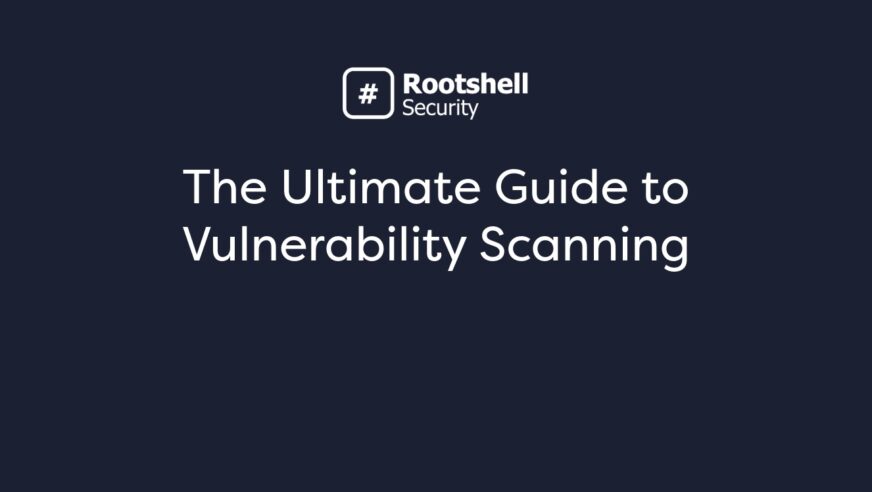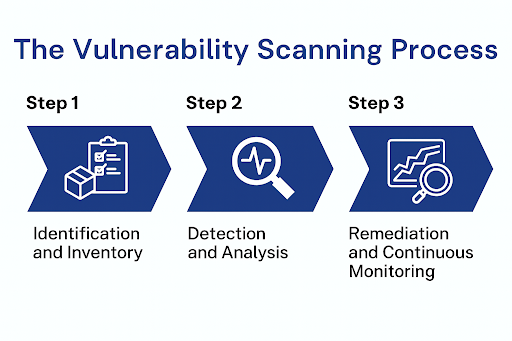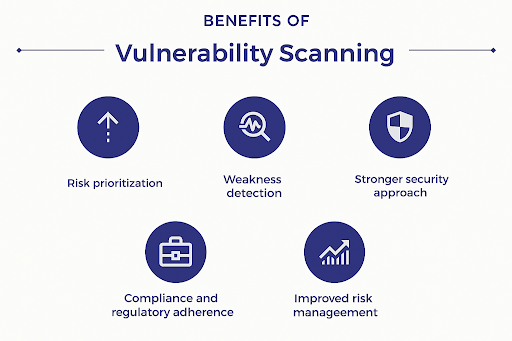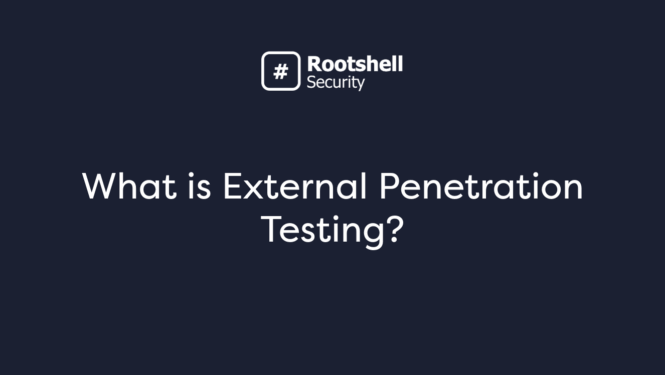Key Vulnerability Management Takeaways:
- Automated Threat Detection: Identify security weaknesses before they can be exploited.
- Improve Security & Compliance: Regular scans help with risk management.
- Pen Testing vs Scanning: Scans find known issues, while pen tests simulate real-world attacks.
- Different Scans for Different Needs: Network, host, app, and database scans cover all bases.
- Beyond Scanning: Vulnerability management is an ongoing process
- Scan Challenges: Address false positives, resource limitations, and scan performance.
- Proactive Protection: Regular scans keep your security posture strong and up to date.
What is Vulnerability Scanning?
Vulnerability scanning is an automated process used to find security weaknesses within an organisation’s systems. It involves using tools to scan for vulnerabilities that cyber attackers could exploit. These scans help prioritise which vulnerabilities need fixing first. Depending on your security goals, you may want to scan a specific system or broaden the scope of the test to assess the entire network. The Technical Guide to Information Security Testing and Assessment identifies vulnerability scanning as a key component of a strong cybersecurity approach and an effective method for discovering and analysing potential threats.
In this ultimate guide to vulnerability scanning, we’ll break down everything you need to know from how it works to its benefits, limitations, and how to implement it as part of a wider security strategy.
The Vulnerability Scanning Process
Discovery and Asset Identification
The first step in vulnerability scanning is identifying and mapping all the assets in the network, such as servers, workstations, devices, and applications. This includes both internal and external-facing assets.
Configuration and Scope Definition
The next step is configuring the scan based on the needs of your organization. This includes defining the scope (e.g., external or internal network, web applications, databases) and selecting the type of scan to perform (e.g., credentialed or non-credentialed).
Vulnerability Scanning
The scan is then performed using tools that inspect the identified assets for vulnerabilities. These tools check for known weaknesses such as outdated software, missing patches, weak passwords, misconfigurations, and potential entry points.
Analysis and Reporting
After the scan is complete, the vulnerability scanning tool generates a report detailing the discovered vulnerabilities. This report typically includes the severity level (low, medium, high) and descriptions of the vulnerabilities, often with recommendations for how to fix them.
Risk Assessment and Prioritization
The identified vulnerabilities are then assessed in terms of risk to the organization. High-risk vulnerabilities that could lead to large data breaches or system compromises are prioritized. Risk prioritization considers factors such as the severity of the vulnerability, the asset’s importance, and the potential impact of an exploit.
Remediation and Mitigation
Once the vulnerabilities are prioritized, teams begin addressing the most pressing issues with a remediation process. This might involve fixing software, reconfiguring security settings, updating passwords, or implementing additional security measures to reduce the attack surface.
Re-scanning
After remediation steps are taken, the system is re-scanned to make sure that the vulnerabilities have been properly addressed. This is an ongoing process, as new vulnerabilities might appear and previously discovered issues could resurface.
Continuous Monitoring and Reporting
Regular scans and continuous monitoring are necessary to make sure your system remains protected, with new vulnerabilities being identified and controlled as they arise.
Benefits of Vulnerability Scanning
Risk prioritization
Vulnerability scanning helps to identify and assess vulnerabilities that present the greatest threat to your organization, offering insights to reduce these risks.
Increased Regulatory Compliance
Regular vulnerability scanning means that you meet industry standards and legal requirements related to cybersecurity. Many regulations ask for vulnerability assessments to make sure sensitive data is protected and security measures are in place.
Cost Savings
Vulnerability scanning can also prevent costly incidents such as data breaches, system outages, and reputational damage. Proactively managing these risks reduces the likelihood of expensive emergency responses, legal fees, regulatory fines, and lost business.
Stronger Security Approach
Vulnerability scanning contributes to stronger security by providing continuous visibility into your systems. It helps to identify things that pose a risk, such as outdated software, misconfigurations, and known vulnerabilities, allowing for timely remediation.
Resources like the Rootshell Platform help you achieve stronger security and smarter risk prioritization by continuously alerting you to the most relevant and high-risk vulnerabilities within your environment. With access to over 250,000 vulnerabilities, the platform consolidates and correlates data from multiple sources, giving you a unified view of how strong your security is.
Types of Vulnerability Scans
Vulnerability scanning can be categorized into several types, each serving a different purpose in identifying and reducing weaknesses in your current security. Understanding the different types helps your company to apply the right scan for the right environment or security objective.
1. Network-Based Scanning
This identifies vulnerabilities in your internal or external network systems, like open ports, misconfigured firewalls, and outdated protocols.
2. Host-Based Scanning
Focuses on individual devices or servers to detect operating system weaknesses, insecure configurations, or missing patches.
3. Application Scanning
Targets web applications and APIs to uncover vulnerabilities like SQL injection, cross-site scripting (XSS), or insecure authentication methods.
4. Wireless Network Scanning
Checks for weaknesses in wireless setups, such as rogue access points or insecure encryption.
5. Database Scanning
Assess the security of databases and associated services, including access controls, data exposure, and unpatched software.
6. Credentialed vs. Non-Credentialed Scanning
- Credentialed scans use login credentials to simulate insider access, offering deeper insight into internal system vulnerabilities.
- Non-credentialed scans mimic an external attacker without access credentials, testing perimeter security.
Features to Look for in a Vulnerability Scanning Tool
Asset Discovery
A good vulnerability scanning tool should automatically discover and log all assets, including devices, applications, operating systems, cloud services, and IoT or legacy systems.
Broad Vulnerability Database
The broader the database, the more thorough the scan in identifying risks across different applications and configurations. A good vulnerability scanning tool should also offer real-time updates, meaning that new vulnerabilities are immediately incorporated into the database. Integrating the database with threat intelligence feeds also means that the tool can stay up to date with threats.
Agentless Approach
An agentless approach to vulnerability scanning lets tools assess systems remotely without installing software on each device. It simplifies deployment, lowers resource use, and reduces the risk of compromised scans, ideal for large or distributed networks. However, it may provide less detailed insights than agent-based scanning, especially where deeper visibility is required.
Support for Internal and External Scanning
A good vulnerability scanning tool should also support both internal and external scanning to provide a complete security overview and protect your attack surface.
External scanning focuses on identifying vulnerabilities in internet-facing assets, whereas internal scanning examines the internal network to detect vulnerabilities within servers, databases, and applications..
Integration with Remediation Tools
A vulnerability scanning tool should integrate with remediation tools or patch management systems to simplify the process of fixing vulnerabilities. When a vulnerability is detected, the scanning tool can trigger automated workflows that send alerts, assign tasks, or initiate efforts to fix the problem through your existing patch management system..
Vulnerability Scanning vs Penetration Testing
Vulnerability scanning and penetration testing are both fundamental methods of evaluating an organisation’s cybersecurity, but they differ in approach and purpose. Vulnerability scanning is typically automated and designed to find known flaws across systems, while penetration testing is a manual, simulated attack that goes further by actively exploiting weaknesses to assess real-world impact.
Here’s a quick overview of the differences between vulnerability scanning and penetration testing:
Aspect | Vulnerability Scanning | Penetration Testing |
Purpose | Identifies known vulnerabilities | Goes further and exploits vulnerabilities to assess real-world risk |
Depth | Broad, surface-level analysis | Deep, targeted exploration |
Method | Automated tools | Manual techniques |
Frequency | Performed regularly | Conducted periodically |
Scope | Large systems or networks | Narrower, defined scope |
Skill Level Required | Lower (automated interpretation possible) | Higher (requires expert ethical hackers) |
Cost | Typically lower | Typically higher |
Compliance Role | Helps meet ongoing compliance standards | Often required for audits or specific regulatory assessments |
Both vulnerability scanning and penetration testing play important roles in a strong cybersecurity strategy. You should not view them as interchangeable but rather complementary. Regular vulnerability scans help you stay on top of known issues, while periodic penetration tests uncover more complex, hidden risks.
The National Institute of Standards and Technology further stresses that interpreting scan results still requires human input to ensure accuracy, highlighting the importance of combining automated tools with expert oversight. For a well-rounded approach, combining both methods ensures continuous monitoring, accurate analysis, and in-depth risk assessment.
Vulnerability Scanning vs Vulnerability Management
Vulnerability scanning provides a snapshot of vulnerabilities at a specific point in time. Vulnerability management, on the other hand, is a broader, continuous process that includes not only scanning but also the analysis, prioritisation, remediation, and tracking of those vulnerabilities over time.
While vulnerability scanning is a part of vulnerability management, strong security requires going beyond the detection phase to ensure that vulnerabilities are properly managed, fixed, and monitored on an ongoing basis. You can think of vulnerability scanning as a subset of vulnerability management.
Challenges in Vulnerability Scanning
When performing vulnerability scans, you may encounter some challenges. There could be some technical limitations, resource constraints, or issues with the tools themselves.
Challenge | Impact | Action to Take |
False Positives | Wasted resources addressing non-issues; real threats may be overlooked. | Use multiple scanning tools and manually review flagged vulnerabilities to confirm actual risks. |
False Negatives | Undetected vulnerabilities can lead to breaches or data loss. | Regularly update scanning tools and manually review assets to catch hidden threats. |
Scan Performance & Downtime | Large scans may slow systems or cause downtime, disrupting business operations. | Schedule scans during off-peak hours, prioritize high-risk assets, and use distributed scanning methods. |
Complexity in Configuration | Poor configuration can result in missed vulnerabilities or inaccurate scan results. | Use automated templates, train teams regularly, and test configurations before full deployment. |
Limited Coverage | Assets like legacy systems or IoT devices may be excluded, leaving security gaps. | Conduct thorough asset discovery, maintain a full inventory, and update scan scopes regularly. |
Resource Constraints | Scanning large networks consumes significant time and computing resources, increasing costs. | Use scalable or cloud-based tools, and prioritize high-risk assets to maximize efficiency. |
Lack of Remediation Integration | Poor integration with patch systems delays vulnerability resolution and complicates prioritization. | Automate workflows, integrate scanning with patch tools, and establish a clear remediation plan. |
Changes in Environment | Dynamic IT environments can cause scans to become outdated quickly, leading to inaccurate risk assessments. | Automate asset discovery and scanning, and run scans regularly to stay up to date. |
Compliance Requirements | Non-compliant scans risk legal and financial penalties. | Use compliance-aligned tools, align scan schedules with audit deadlines, and stay updated on industry regulations. |
Lack of Skilled Personnel | Limited expertise delays remediation and increases the risk of overlooking serious vulnerabilities. | Provide staff training, use automated reporting, and consider outsourcing to cybersecurity professionals if internal resources are limited. |
To overcome these challenges, you need to take a strategic and proactive approach. This includes not only selecting the right tools but also making sure they are properly configured, regularly updated, and integrated with other security processes. Clear documentation, staff training, and automation can all help streamline operations and reduce manual workload.
Most importantly, scanning should never be seen as a one-off task; it must be part of a continuous vulnerability management cycle that includes discovery, prioritisation, remediation, and verification.
Integrating Vulnerability Scanning into Your Cybersecurity Strategy
Integrating vulnerability scanning into your approach to cybersecurity, organisations make it easier to find and reduce security risks before they can be exploited. To get the most from vulnerability scanning, organisations should define how often scans are run, based on risk tolerance and the threats they are up against. You should establish clear vulnerability management processes, allocate appropriate resources, and regularly review your strategy. It’s also important to encourage a culture of cybersecurity by educating employees on their role in keeping systems secure. When integrated properly, vulnerability scanning becomes a powerful tool that helps strengthen your security and reduce risk across the business.
Book a demo with Rootshell Security to learn how our expert-led vulnerability scanning and management solutions can support your cybersecurity goals today.





